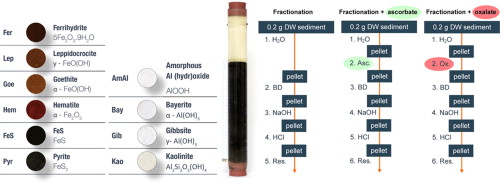 Correct identification of P forms together with their main Fe and Al binding partners in non-calcareous sediments is of crucial importance for evaluation of P cycling in water bodies. In this paper, we assess extraction methods frequently used for this purpose, i.e., a sequential five-step fractionation (water, bicarbonate buffered dithionite solution (BD), NaOH, HCl, nitric-perchloric acid), ascorbate extraction (pH ∼7.5), and oxalate extraction (pH ∼3), directly on a range of laboratory prepared Fe and Al minerals enriched with adsorbed P. Extraction selectivity and efficiency for particular P, Fe and Al forms were also verified by specific combinations of these extraction methods applied on freshwater sediment samples. In the sequential fractionation, BD was highly effective in dissolving both amorphous and crystalline Fe (hydr)oxides and the associated P, while neither FeS nor Al (hydr)oxides were dissolved. The following NaOH extraction effectively dissolved both amorphous and crystalline Al (hydr)oxides. The high solubilizing power of BD and NaOH to dissolve crystalline Fe and Al oxides that have only a small P-sorption ability prevents the use of resulting Fe/P and Al/P ratios as simple predictors of total P sorption capacity of sediments and soils. Ascorbate non-selectively extracted small proportions of FeS and amorphous Fe and Al (hydr)oxides, but significant amounts of adsorbed P, which hinders its use for the characterization of P forms in non-calcareous sediments. Similar nonselective characteristics were found for oxalate extractions. As oxalate extracts most of the adsorbed phosphate, it is not possible to use it unambiguously to determine specific Fe/P and Al/P ratios of active complexes. However, this method is convenient (and more selective than NaOH step in the sequential fractionation) for the determination of amorphous Al (hydr)oxides.
Correct identification of P forms together with their main Fe and Al binding partners in non-calcareous sediments is of crucial importance for evaluation of P cycling in water bodies. In this paper, we assess extraction methods frequently used for this purpose, i.e., a sequential five-step fractionation (water, bicarbonate buffered dithionite solution (BD), NaOH, HCl, nitric-perchloric acid), ascorbate extraction (pH ∼7.5), and oxalate extraction (pH ∼3), directly on a range of laboratory prepared Fe and Al minerals enriched with adsorbed P. Extraction selectivity and efficiency for particular P, Fe and Al forms were also verified by specific combinations of these extraction methods applied on freshwater sediment samples. In the sequential fractionation, BD was highly effective in dissolving both amorphous and crystalline Fe (hydr)oxides and the associated P, while neither FeS nor Al (hydr)oxides were dissolved. The following NaOH extraction effectively dissolved both amorphous and crystalline Al (hydr)oxides. The high solubilizing power of BD and NaOH to dissolve crystalline Fe and Al oxides that have only a small P-sorption ability prevents the use of resulting Fe/P and Al/P ratios as simple predictors of total P sorption capacity of sediments and soils. Ascorbate non-selectively extracted small proportions of FeS and amorphous Fe and Al (hydr)oxides, but significant amounts of adsorbed P, which hinders its use for the characterization of P forms in non-calcareous sediments. Similar nonselective characteristics were found for oxalate extractions. As oxalate extracts most of the adsorbed phosphate, it is not possible to use it unambiguously to determine specific Fe/P and Al/P ratios of active complexes. However, this method is convenient (and more selective than NaOH step in the sequential fractionation) for the determination of amorphous Al (hydr)oxides.
Keywords: aluminum; ascorbate; iron; oxalate; phosphorus; sequential fractionation


